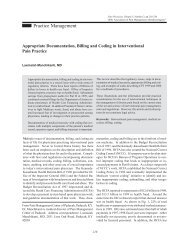ASIPP Practice Guidelines - Pain Physician
ASIPP Practice Guidelines - Pain Physician
ASIPP Practice Guidelines - Pain Physician
Create successful ePaper yourself
Turn your PDF publications into a flip-book with our unique Google optimized e-Paper software.
Manchikanti et al • <strong>ASIPP</strong> <strong>Practice</strong> <strong>Guidelines</strong><br />
29<br />
Table 2. Prevalence of low back and neck pain in general population ranked by severity<br />
and disability<br />
<strong>Pain</strong> grade Low back pain Neck pain<br />
Grade I<br />
Low pain intensity and disability<br />
Grade II<br />
High pain intensity and low disability<br />
Grades III and IV<br />
High pain intensity with moderate and severe disability<br />
47% 39%<br />
12% 9%<br />
13% 5%<br />
Total 72% 53%<br />
Data modified and adapted from Cassidy et al (118) and Côté et al (119)<br />
that chronic pain is a frequent complaint even in childhood<br />
and adolescence. The International Association for<br />
the Study of <strong>Pain</strong> (IASP) appointed task forces to study<br />
the epidemiology of pain in 1996 (110), and pain in the<br />
elderly in 1999 (111) with publication of two large reports<br />
of 137 and 320 pages. It was consistently shown that elderly<br />
suffered with not only pain of longer duration, but<br />
with higher frequency (100-105, 108, 111-116).<br />
Among the chronic pain problems, spinal pain which includes<br />
pain emanating from cervical, thoracic and lumbosacral<br />
regions constitutes the majority of the problems.<br />
It is estimated that episodes of low back pain that are frequent<br />
or persistent have been reported in 15% of the US<br />
population, with a lifetime prevalence of 65% to 80% (103,<br />
113). However, prevalence of neck pain, though not as<br />
common as low back pain, is estimated 35% to 40% (114,<br />
115), of which 30% will develop chronic symptoms (116).<br />
In contrast, the epidemiological data in relation of thoracic<br />
pain support the view that the thoracic spine is less commonly<br />
involved. Linton et al (117) estimated prevalence<br />
of spinal pain in the general population as 66%, with only<br />
15% of those reporting thoracic pain; in comparison to<br />
56% to 44% for the lumbar and cervical regions respectively.<br />
Cassidy and colleagues (118) assessed the 6-month<br />
prevalence of chronic low back pain and its impact on general<br />
health in the Canadian population. The results showed<br />
an 84% lifetime prevalence, with 47% of the patients reporting<br />
grade I pain (low pain intensity and low disability);<br />
12% grade II pain (high pain intensity and low disability);<br />
13% grade III (high pain intensity/moderate disability),<br />
and grade IV (high pain intensity/severe disability)<br />
(Table 2). They also reported that grade I low back<br />
pain was more common in the younger population while<br />
older age groups reported higher incidence of grade III/IV<br />
pain. Thus, a total 13% of the population suffers with high<br />
Table 3. Chronicity of low back pain<br />
Prevalence<br />
Author(s) Year of Publication 3 months 12 months<br />
Anderson and Svensson (122) 1983 20% 10%<br />
Van Den Hoogen et al (123) 1997 35% 35%<br />
Croft et al (124) 1998 79% 75%<br />
Carey et al (125) 1999 N/A 20% to 35%<br />
Meidema et al (126) 1998 N/A 28%<br />
Thomas et al (127) 1999 48% 42%<br />
N/A = Not available<br />
<strong>Pain</strong> <strong>Physician</strong> Vol. 4, No. 1, 2001
















